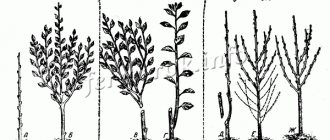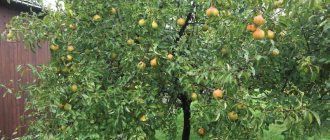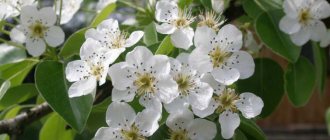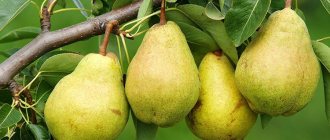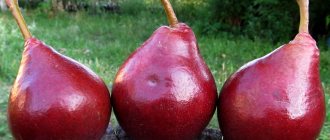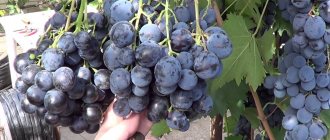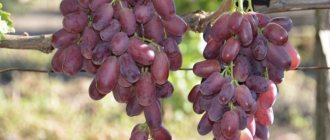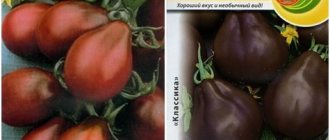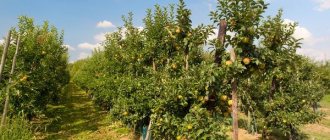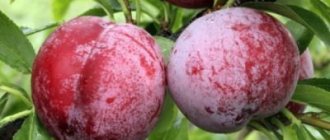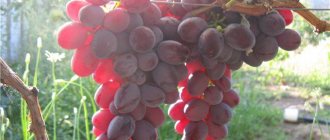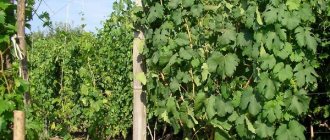Gardening » Pear
0
1731
Article rating
Kira Stoletova
Among the summer varieties with stable fruiting, the Children's pear is especially popular. It was bred by a breeding institute in Moscow as a result of crossing summer Duchess and hybrid No. 8.
Characteristics of the Children's pear variety
Pear variety Children's: photo, description
Pear variety Children's
According to surveys conducted recently, the Children's pear variety is one of the most popular fruit trees grown by both novice gardeners and true professionals.
People are attracted not only by the incredible unpretentiousness of this plant, but also by how tasty and numerous its fruits are. This is why the pear tree is becoming more and more popular every year, and breeders continue to develop completely new and revolutionary varieties.
This happens by crossing existing varieties that have useful and irreplaceable qualities. As a result of precisely this genetic crossing, a pear variety called “Children’s” appeared.
Despite its simple and naive name, this variety rightfully takes its place among not only the most commonly grown, but also objectively the best pears in the whole world, and therefore in this article we decided to tell you everything that is known about this variety so that you can It’s no problem to grow it on your own plot and delight your family with amazingly tasty fruits.
Which group does it belong to?
There are different groups of pears, which include completely different varieties. The principle of division into groups is as follows: there are summer, autumn and winter trees. As you probably understand, trees whose fruits ripen in the summer belong to the first group, those whose fruits ripen in the fall - to the second, and those whose fruits ripen by winter - respectively, to the third.
Our object of discussion, the Children's pear, belongs to the summer group. Its fruits ripen between July and August. Sometimes, if weather conditions were unfavorable, this date may well be postponed to the beginning of September, however, such situations are exceptions to the rule.
History of the variety
The pear variety called Children's was bred by a very famous and professional breeder, who has a huge variety of plant varieties. His name was Yu. A. Petrov, and N.V. helped him in this. Efimov. Together at the All-Russian Breeding and Technological Institute in Moscow, they created this outstanding variety, which in the future ensured that they received more than one award.
It is also reliably known which hybrids were created in order to obtain the Children's Pear when crossed. It was a pear called Summer Duchess and a hybrid variety number eight, which does not have any scientific name.
Most often, this variety can be found in our regions, since it is excellent for our weather conditions and, accordingly, is not very common abroad. Nevertheless, the popularity of the Children's Pear in our country, as you probably know, is at its best.
What type does it belong to?
Depending on the time of fruit ripening, pears are divided into summer, autumn and winter. Pear variety "Children's" is a summer variety. The fruits of this variety ripen in the summer, from mid-July to mid-late August.
Summer varieties also include Duchess, Chizhovskaya, Carmen, Moskovskaya rannyaya and Orlovskaya Letnyaya.
Pear variety Children's: photo, description of botanical characteristics
Pear variety Children's
Trees of this variety reach quite impressive heights, and, accordingly, they are extremely durable and can serve the gardener for decades. The crown of these trees has the shape of a pyramid.
The branches that form it are quite few. However, they are very powerful and branchy, which allows them to produce a huge number of leaves and fruits.
The shoots of the tree are small, but very straight and thick.
As for the leaves, they do not at all correspond to the rather large dimensions of the tree itself and are most often presented in rather small sizes. However, they are quite beautiful and have a regular pointed geometric shape.
Their abundance allows the tree to receive a lot of energy through photosynthesis and use it to grow, becoming even larger and stronger.
The fruits of this plant, however, like its leaves, cannot exactly be called gigantic. However, they are not small either. We can say that they are medium in size, and their weight reaches about eighty (in rare cases, one hundred) grams.
In order to determine whether the fruit has reached maturity, you just need to look at its yellowness. Despite the fact that pears are light green in color, the yellower they become, the riper they are.
They can also sometimes show small orange-rusty specks that complement the simple but elegant appearance of the fruit, making its presentation even better and more attractive to buyers.
History of selection and region of breeding
The “Children's” variety was bred by famous breeders Yu.A. Petrov and N.V. Efimova at the All-Russian Selection and Technological Institute of Horticulture and Nursery Science (VSTISP), Moscow.
The variety was obtained by crossing interspecific hybrid No. 8 with the Duchess summer pear variety.
Basically, the variety is distributed in private plots of Moscow and neighboring regions. This variety is zoned in the Central region.
The pear varieties Gera, Cathedral, Krasnobokaya, Elena and Vernaya grow well in this region.
Children's pear: description of the variety, photo, characteristics
Children's pear
The yield of the Children's pear is impressive and really compensates for the far from impressive size of the fruit. However, before you have the opportunity to collect fruits from this tree, you will have to wait about four, and in some cases, five years.
However, even such terms are a rather gentle waiting time, since, considering some other varieties, we can find that they can last for seven or eight years to see the fruit appear.
Against such a background, the Children's Pear clearly stands out positively for its early summer appearance.
As already mentioned, you can start harvesting at the beginning of July, and this procedure may end at the end of summer, since the fruits ripen unevenly. Therefore, in no case should you collect fruits on the same day. It is much better to stretch out this process over several weeks so that the pears are overripe or, conversely, not picked under-ripe.
As for the taste qualities of the variety, many gardeners and consumers note that they prefer this pear precisely because of them.
The pulp of the fruits of this tree is very soft and silky. They are also quite juicy, which allows them to be used in completely different areas of cooking: pears can be eaten raw or used to prepare desserts, compotes and even some sauces.
It should also be noted that these fruits have very good preservation, and therefore, at suitable temperatures, they can be stored for quite a long time. Of course, Children's Pear cannot compete with varieties whose fruits last up to six months, but keeping the fruits fresh for a month is not a problem for this variety.
Also, the positive qualities of this pear variety include its frost resistance. Surely, one can even note that this factor was far from the last of those thanks to which this variety took root so well in our country.
Not only do trees withstand fairly low temperatures, but they are not damaged in any way and remain completely intact.
In addition, the Children's pear variety copes well with sudden changes in weather conditions, which is often a problem for some other pears, and therefore spring frosts or sudden autumn thaws are tolerated without any problems.
And, of course, the undoubted advantage of this variety is that it is absolutely self-fertile, and when planting it, you won’t even have to think about planting any other trees nearby that would serve as pollinators.
Advantages and disadvantages of the Children's pear variety
Due to its early ripening period, the variety is excellent for growing in gardens and summer cottages. The strengths of the pear include:
- frost resistance of trees that are not damaged by cold in the middle zone;
- regular fruiting;
- high productivity;
- gradual return of early harvest;
- resistance to common fungal diseases;
- excellent taste of pears.
In addition, summer residents classify the variety as partially self-fertile. However, in the presence of pollinators, the Children's pear sets up to 40% more fruits. At the same time, the Chizhevskaya, Lada, and Cathedralnaya pear trees bloom.
The pear has few disadvantages. One of them is the height of the trees. In order not to lose part of the harvest, the gardener will have to regularly engage in reducing pruning. In addition, the pear fruits of this variety cannot be called large.
Planting and caring for the plant
Many gardeners prefer to grow pears, neglecting other garden trees, because pear care is incredibly simple, and the tree is completely unpretentious. By the way, as we said, this is one of the main reasons for the enormous popularity of this variety among novice and non-professional gardeners.
However, the procedures for caring for this plant, although they are not at all complex, must be extremely regular and constant, since these are the qualities that trees love and respect most, and, therefore, reward those gardeners who provide them with decent care and a decent harvest.
First of all, of course, you will have to take care of planting, because it is not for nothing that they say that at least half of the success of a future plant lies in planting. That is why you will have to very strictly follow the rules we describe below in order to make your tree the most effective and prolific.
Pear variety Children's: selection of seedlings
In fact, the planting procedure begins long before you dig a hole for the seedling and plant it in it. This process begins with choosing the right and healthy seedling, since if your choice falls on insufficiently good planting material, you may find yourself disappointed by how ineffective your tree is and how unpalatable your fruit is.
In order to avoid such disappointment, it is necessary to understand the criteria for selecting good planting material. First of all, you should pay attention to the age of the seedlings: the younger they are, the better. One-year-olds adapt to new and unfamiliar conditions much more easily than, for example, two-year-olds, and therefore you should give your preference to them when purchasing.
You should also pay attention to the roots of the seedling you buy. The root system must be moderately lumpy, and the roots themselves must in no case be damaged or infected. As soon as you see a cut or fracture on the root, it is better to immediately abandon such a plant.
Once you have examined the root and are satisfied that it is good enough, you should turn your attention to the bark, branches, trunk and crown. If they all look quite healthy and developed, then you can purchase this planting material without any doubt and have absolutely no doubt that it will not let you down.
Boarding time
Now that you have a seedling, you need to figure out when you will plant it. Many gardeners do not attach much importance to this, but in fact, the correctly chosen planting time determines how quickly and successfully the seedling can take root in the conditions of your site, as well as how prepared it will be to face the winter cold.
Absolutely all professional gardeners unanimously say that the best time to plant not only pears, but absolutely any other plant is spring. Children's pear is no exception to this rule, and therefore we recommend that all planting work be carried out in the spring.
To make planting even more effective, planting should be done when there is no risk of return frost. To be sure of this, you should wait about four days after the weather has become relatively stable, and start planting only if no frost is expected after this period.
After this, you will have about two weeks to carry out the procedure, since when they are over, the active phase of the flow of juices in the plant will begin, while it is highly advisable to plant the pear before this phase begins.
In order to speed up the process and with one hundred percent probability it will fit within the two weeks given to you, we advise you to dig holes not in the spring, but in the fall - a quarter of the year before planting. This way, you can not only not waste time digging a hole in the spring, but you will also be sure that all the substances that you added to the soil are perfectly mixed and settled.
If you bought a seedling in the summer, then planting can be carried out in the fall, but you must understand that such a time frame for this procedure is associated with certain risks, and therefore we advise only the most experienced gardeners who are completely confident in their abilities to carry it out. only if you can afford to sacrifice a seedling in case of failure. Otherwise, it’s better to wait until spring.
Selecting a location
The planting location is also a very important factor, which greatly influences the further development of the tree. First of all, it is very important to provide good lighting for the plant, since without it the pear will not be able to grow normally.
It is also strictly forbidden to plant a pear in any depression, such as a natural depression. The fact is that during precipitation, and especially during snow melting, it is in such lowlands that all the water will accumulate, which will lead to excessive moisture in the plant and, as a result, to the possible appearance of such an unpleasant disease as root rot.
Also, to avoid a similar fate for your plant, you should check the place where it is planted for the presence of groundwater. They must be located at a depth of more than two meters, since otherwise the same scenario will occur as described in the previous paragraph, but this time much faster and more rapidly.
You should also ensure that the growth of the plant’s roots is not interfered with by fences or building walls, and therefore you should keep a distance between them and the planting site. The same applies to the location of two plants relative to each other, since, being planted at too small a distance, the trees will constantly compete for nutrients and interfere with each other with their crowns, which, naturally, will not lead to anything good.
Pear variety Children's: planting procedure
First of all, if you haven’t dug a hole yet, you need to start there. The depth of the planting hole should be about half a meter - seventy centimeters (depending on the size of the rhizome of your pear). In diameter, this recess should reach about one meter.
It is also very important to provide the plant with all the nutrients and minerals that will nourish it during the first two to three years of rhizome growth. It is these first years that are the most important in the formation and development of the root system, and therefore you should pay close attention to fertilizer in the fall.
To begin with, you will need to select good, fertile soil, which you probably have in your possession. Next, we add one bucket of humus, which will not only provide nutrition to the plant, but can also create additional protection during the winter cold.
Well, in order to accelerate the growth and development of the plant, you should add about two hundred grams of superphosphate and fifty grams of nitrate to the resulting soil mixture. It is also advisable to add about one hundred grams of potassium sulphide. All of these ingredients will work together to create a healthy, strong, and large root system.
Important!
Many people believe that humus and manure are equivalent organic fertilizers, and therefore they are interchangeable. However, this is absolutely not true, and using manure instead of humus in the above recipe can be a fatal mistake that will destroy your tree. Its unprepared, young roots will simply burn out, and the tree will soon die.
Now that the hole has been dug and filled with all the necessary nutrients, it is necessary to create a small earthen hill at the bottom of the same hole, which will consist of the soil mixture we prepared. This hill should not be too large, but high enough so that all the roots of the seedling can be placed on it.
Now the root system of the planting material is carefully distributed over the surface of this very hill so that the roots do not get tangled or interfere with each other, and also that they are directed in different directions. This seemingly simple procedure will ensure the stability of your future tree.
All that remains is to fill all the remaining cavities with soil. It is very important to compact the soil you are filling. However, this should be done without excessive fanaticism, since if you compact the soil too much, you may well damage the roots.
On the other hand, if you do not compact the soil mixture enough, or do not compact it at all, you greatly increase the risk of air bubbles forming in the hole, the appearance of which can cause root rot.
When filling a hole with soil mixture, you should also take care of watering the hole, since the sprout will need a very powerful initial push, which will help it adapt to growth in open ground, and also give it enough useful substances to immediately start growing.
In addition, water will also be beneficial because it will further compact the soil and prevent the formation of air bubbles.
However, when watering, you don’t need to be too fanatical, since too much moisture can lead to stagnation of water at the roots and their premature rotting. So, by going too far with the amount of watering, you can only bring about the problem from which you were trying to protect the plant.
By the way, the following point should be mentioned: the seedling that you choose, despite the fact that it has an ideal root system, trunk and crown, may have some defects, such as a bent trunk. They are not critical and the tree can easily live with them, but it will also need special conditions that will help it adapt to existence with such a defect.
Therefore, if the trunk of your plant is curved, you should plant it in such a way that it is directed to the south, and, accordingly, as the seedling reaches for the light, it will straighten.
However, even this does not end the landing procedure. The fact is that at first the seedlings will sit in their holes extremely unsteadily, and therefore they will need help. Such support can be provided by an ordinary garter to a peg firmly driven into the ground. In addition, such support will allow the plant to grow exceptionally evenly.
We also strongly advise you to carry out the mulching procedure immediately after planting. We have already spoken about the usefulness of this procedure more than once in our articles, and we will repeat it again. Not only does mulch prevent moisture from prematurely evaporating from the soil surface on particularly hot days, it also protects the plant from the invasion of snails and slugs, and also prevents weeds from receiving solar energy and preventing them from growing normally.
How to plant a pear tree
The pear is an unpretentious drought-resistant crop; growing a fruit tree is quite simple.
Landing dates
Planting work is carried out in early spring or September. The timing is selected depending on the region and variety. In central Russia, early spring planting is more often carried out, since the seedlings must have time to get stronger by the onset of the first winter. The optimal time is after the snow has melted and the soil has thawed to such a state that it is possible to dig a hole.
The Children's pear is characterized by high frost resistance, so even autumn planting will not affect survival rate and full wintering.
Choosing a place for a pear, soil
The southern part of the garden is the best place for planting heat-loving crops. Cold winds should not blow through the area. For proper development, a maximum level of illumination is needed. The occurrence of groundwater is no closer than 2.5 m from the soil surface. Mature trees have a developed root system, going 6-8 m deep. If the aquifer is too close, there is a risk of developing root rot.
Children's pear does not have high requirements for soils. Loose, permeable, fertile substrates are ideal for it. If the land on the site differs from the requirements, it is recommended to improve it. Sand will help increase lightness and looseness, and adding humus or compost, coupled with mineral fertilizing, will increase soil fertility.
How to choose a seedling
Good survival rate is characteristic of seedlings at two years of age. A thorough external examination should not reveal any traces of damage or disease to the shoots and root system. Healthy parts of the plant are flexible, living, developed.
It is better if the seedling has at least 3 main roots, surrounded by a dense network of smaller roots.
Carrying out planting work
Detailed landing instructions:
- a month (at least 2 weeks) before the intended planting of seedlings in open ground, dig a planting hole in the selected area with a depth of 0.8-1 m and a diameter of 60-80 cm, leaving a step between specimens of 5 meters;
- mix the excavated soil thoroughly with 3 buckets of humus and a bucket of sand; when planting on poor soils, add the full mineral complex;
- Pour the prepared soil mixture into a mound onto the bottom of the hole and water generously. Planting begins after the soil settles;
- 6 hours before planting, place the roots of the seedling in a bucket of warm water. Immediately before planting, dip them in a clay mash;
- Drive in a support stake and distribute the roots of the seedling over the earthen embankment. Make sure that the root collar protrudes relative to the surface of the earth by 4-7 cm;
- plant young shoots, periodically shaking the roots. This measure will prevent the formation of air bubbles;
- add the remaining substrate and compact it gently. After forming a near-trunk circle with a diameter of 0.5-0.7 m, water the planted plant generously;
- tie the trunk to the support, mulch the tree trunk area with peat.
Do not try to compact the soil around the seedling too much; it should remain permeable for proper root respiration.
Crown formation
As you already know, the Baby Pear tree is quite tall, and therefore the larger and taller it becomes, the more randomly its crown will grow. Your task as a gardener is to avoid this, since an irregularly shaped crown is fraught with some unpleasant consequences.
First of all, it should be noted that the more fruits are formed on the tree, the more their taste and, accordingly, their size will decrease. In addition, a huge number of branches that obscure each other will interfere with the normal process of photosynthesis.
That is why it is advisable to maintain the shape of the crown pyramidal. You should also pay close attention to ensure that the branches grow at the correct angle (about ninety degrees or perpendicular to the trunk). This must be done from the very moment of planting, since when the branches grow and become stronger, it will be extremely difficult to correct their shape.
First of all, you should take care of those branches that grow at the wrong angle. If you see branches growing at too sharp an angle relative to the trunk, they should be corrected with special spacers.
If branches are observed growing at an obtuse angle, the method of tying the branch to the trunk with twine or ordinary garden rope is used. It is also advisable to place a rubber lining on the branch, which will prevent the rope from damaging the bark.
After some time of such influence on the branch, it will straighten and begin to grow at the right angle. As the tree develops, these branches will become strong and stable, and therefore they will no longer be able to straighten into the previous incorrect state.
As for pruning, which is one of the key procedures in gardening, it is completely undesirable to apply it to young trees, since at such an early age it may not have a positive effect on the health of the plant. However, sometimes this procedure is simply necessary. Especially if there is any damage on the branches or if they are very long.
In order for pruning to be carried out safely and without unpleasant consequences for the tree, you should make sure that you use only sharp and high-quality tools that will not leave unnecessary scars on the branch that are not at all conducive to healing.
It is also advisable to lubricate the cut site with crushed charcoal or garden varnish, which will prevent infection from penetrating inside the plant.
In order for the crown to form correctly, you will need to have no more than five to six load-bearing (also called skeletal) branches. It is they who will be responsible for the formation of the crown, and it is on them that ninety percent of the fruits will form, and therefore their good condition is your primary task.
For the formation of fertile and effective branches, the development of strong and reliable shoots is also very important, and therefore they also need to be controlled. If we are talking about skeletal branches, then the formation of shoots on them at an acute angle is completely unacceptable, since they may not be strong enough, which ultimately, when the fruits begin to form, will lead to the shoots simply breaking off.
The procedure itself for pruning and forming shoots and branches is carried out exclusively in the spring, since it is at this time of year that the plant is least susceptible to any external influences and has the strongest immunity to be able to successfully survive such a traumatic procedure.
It is also very important to make the angle of absolutely every cut about forty to five degrees. In this way, you will ensure that the tree quickly heals the cut site and completely prevents viruses and bacteria from penetrating inside.
The crown, like the root system, takes four to five years to form, and therefore, when the tree is already formed, the need for constant pruning will simply disappear, since all the shoots and branches will grow correctly.
However, pruning should not be completely avoided. The only difference is that it will serve exclusively preventive purposes. To be more precise, it will be needed in order to remove damaged and diseased branches.
Trimming
Children's pear is a variety that requires shaping and pruning.
It begins after planting the seedling; for this, the top of the central trunk is cut off at the level where the tree begins to form a crown. Gardeners practice doing this at a height of 1.3-1.5 m. The cut is made above the developed bud with sharp pruning shears, then covered with garden varnish. Mature pear trees are pruned every spring. Correct the shape of the crown, cut out old and dried branches, and also clean out branches that grow inward and thicken the crown. All cuts are carefully covered with garden varnish.
Pear variety for the garden - choosing the best
How to plant a pear. Old-fashioned method.
Pear variety Memory of Yakovlev
Gardening, pear varieties.mp4
With the help of pruning, you can not only form a beautiful tree, but also protect it from the development of fungal diseases that occur when the crown thickens and poor ventilation.
Pear variety Children's: protection from cold
As already mentioned, this pear variety is extremely resistant to cold, which is one of the main factors for its popularity in our country. Especially if we are talking about an adult and mature tree, it does not need any shelter at all.
However, young trees, especially in the event of very severe frosts, can be significantly damaged. This is especially true for the root system, which at this stage of development still remains very vulnerable and weak.
Therefore, it is necessary to provide winter protection primarily to young seedlings, and this should be done in the area of the root collar and the root part of the trunk.
The best way to protect these parts from frostbite is to use extremely extensive mulching, as well as wrapping them with garden cloth, which will not allow the cold to damage the delicate tissues of the plant.
Care after landing
Now that you have completely completed the planting procedure and the first crown-forming pruning, we can say that all the difficulties associated with caring for this plant are left behind. Quite simple procedures await you ahead, the most important rule in the implementation of which is frequency and consistency, and therefore you should not have any problems.
The best summer pear varieties
The earliest varieties of pears are summer ones, which are distinguished by better taste, resistance to diseases, weather conditions, abundant fruiting, and drought resistance.
But at the same time, it is important to carry out preventive treatment and feed the plants in a timely manner. The fruit is covered with a thin skin that contains a soft, juicy texture.
You won’t be able to store them for as long as winter and autumn harvests, but you can use them in making juices, jams, compotes, etc.
Duchess
One of the most common varieties of pear around the world. It is distinguished by a lot of properties - unpretentiousness to the land, climate, stability of harvest, high tasting scores. The summer species of Duchess is not self-fertile; it requires pollinators. Flowering begins late compared to other trees of this type, the flowers are large and resistant to cold, even withstanding frost. You can enjoy Duchess 5-6 years after planting. One fruit weighs 170 g, has an elongated shape, a lumpy surface with a thin yellow peel. Unlike all the predecessors in the rating, this one has the most pronounced aroma with notes of nutmeg and taste. It can be picked by mid-August and stored for no longer than 1-1.5 months.
Advantages
- Unpretentiousness;
- Low risks of diseases (including scab);
- Tasting assessments;
- Appearance of fruits;
- Versatility of purpose;
- High potential.
Flaws
- The tree needs treatment against aphids, Shrovetide;
- The need for a pollinator.
The drier the soil, the sweeter Duchess will be, so experts advise choosing elevated areas for planting. Due to its high sweetness, the tree is loved by aphids, carnival and other pests, so regular treatment is needed. One mature plant can produce up to 250 kg, but this will require a pollinator nearby.
Victoria
A late-summer ripening crop whose fruits reach ripeness in the second half of August or early September. They can be collected in the 6th year after planting in the ground. Despite the fact that flowering often occurs during the period of spring frosts, the weather does not affect the ovary in any way. From the trees that breeders crossed, Victoria inherited high gastronomic ratings, frost endurance, and stable potential. As it grows, it reaches 5 m in height and acquires a spreading crown of a rounded pyramidal shape. A pear with a regular symmetrical shape is a dessert variety, juicy and sweet; it can weigh from 115 to 260 g, and due to its thin structure it is rarely used in canning. Victoria rarely crumbles and is stored for up to 3 months at 5 degrees.
Advantages
- Frost resistance;
- Presentable appearance;
- High gastronomic scores;
- High immunity;
- Drought tolerance;
- Stable harvest.
Flaws
- With a lack of sun, glucose in the composition decreases;
- Potential only in warm climates.
For 100% benefit, such a plant requires direct access to sunlight. This also affects the sweetness of the harvested fruit. The best growing environment is in regions with a warm climate.
Cathedral
The review ends with a seemingly simple pear, which can be bought inexpensively at any seedling market. In fact, this is a tree with great potential, stable, reliable, and easy to care for. It is distinguished by its medium size, conical crown, and sparse branch growth. Despite the fact that this is a summer plant, the ripening period depends on the weather and the number of sunny days. By the beginning of autumn, fruiting ends in any case. On average, one plant produces up to 40 kg of pears; the potential can be increased if you plant it next to pollinated relatives. The difference from other summer varieties is their unique resistance to frost down to -30 degrees, scab, and other fungal infections. The fruits are characterized by a regular shape, slightly uneven skin, weight 120-140 g, medium density filling with a fine-grained delicate texture. The aroma is weak, but there is an oiliness, a pronounced sweet-sour and juicy motif.
Advantages
- Tolerance of adverse weather conditions;
- High stable yields;
- Rapid maturation in 3-4 years of life;
- Low risks of fungi, scab;
- Presentable appearance;
- Availability.
Flaws
- Poor transportability;
- Short shelf life.
The Cathedral variety can be stored for only a couple of weeks, so it is more often used for preparation, preservation, and drying. You can feed only from the second year of life in the ground. Responsible care and protection of the tree must be provided in the first years. The gastronomic characteristics are not inferior to their southern relatives, according to reviews.
Watering, fertilizing
Of course, when we talk about constant, routine plant care, watering comes to mind first. In fact, it should be noted that this plant does not need to be watered very often. On average, this procedure is carried out only when the ground around dries out, which, given the effects of mulch, does not happen often.
If the soil around the tree is quite moist, then, regardless of any timing, you should under no circumstances start watering, since, as you already know, excessive waterlogging can lead to major problems for the plant.
Simply put, you should always try to stay in the golden mean area, when the plant is not too waterlogged, but also does not die of thirst at the same time. That is why maintaining balance is the most important thing when watering.
Of course, absolutely every gardener wants his plant to be as prolific and efficient as possible, and therefore, if you want the same thing, which we do not even think to doubt, you need to think about providing your plant with the best fertilizers .
In addition, minerals such as nitrogen help the plant not only grow and develop faster, but also begin to bear fruit earlier, which, without any doubt, is a huge plus for traders who want to push their product to market as early as possible. market.
In order for nitrogen fertilizer to have the most beneficial effect on the plant, it should be administered according to the following instructions:
Approximately fifty grams of ammonium nitrate is scattered evenly around the trunk, after which the ground is dug up so that the fertilizer can mix with the soil and settle in it.
However, you need to be extremely careful when using a shovel, since the root system of almost any pear spreads very close to the surface and, accordingly, you can completely accidentally and unintentionally damage it.
In addition to feeding pears with saltpeter, we recommend that you use sodium humate. This is done only three times a year: the first time - when the buds begin to bloom, the second time - in July, when the first fruits begin to appear, and the last time - at the very end of August, when the fruit harvest comes to an end.
This frequency will allow the plant to distribute its resources most effectively, successfully survive the winter and be filled with energy at the beginning of the next season.
Description of Rainbow pear
First of all, the crop is distinguished by its ability to develop and bear fruit in harsh climates and infertile soils. Despite the fact that the Rainbow pear variety has been cultivated for more than 40 years, this may be why there are not so many photos and descriptions about it. In some ways they even contradict each other.
The Rainbow Pear grows from medium to tall sizes depending on the region. The crown is round or oval, widened towards the bottom. Spreading is average. The number of shoots is also small. The shoots are of medium thickness, predominantly brown-green in color.
The leaves of the Rainbow pear have an elongated ellipse shape. The surface of the sheet plate is smooth, with a glossy sheen. The leaf color is rich green in early summer and dark green in late summer. The buds are small, cone-shaped, covered with glossy brown skin. Rainbow pear blooms profusely, with flowers with seven white petals.
According to the description, reviews and photos of gardeners, the Rainbow pear forms fruits weighing 140-180 grams, which is slightly above average. The fruits have the shape of a truncated cone with a wide base. The skin is thin, light green in color. With maturity, yellow shades and a slight pink blush appear. To the touch, the fruits of the Rainbow pear are oily, with a waxy sensation.
Rainbow pear deserves extremely positive reviews about its taste. The skin is very thin and delicate. The flesh of the fruit is milky white, sometimes with a slight yellowish tint. It tastes very juicy and sweet, without astringency or astringent properties. The high sugar content, which is 12-13%, allows us to classify the Rainbow pear variety as a dessert one. According to various sources, the tasting score ranges from 4.2 to 4.5 points.
According to descriptions of the Rainbow pear variety, confirmed by reviews from gardeners, the fruit crop is unpretentious and resistant to harsh weather conditions. At the moment, the variety has not been registered in the State Register of the Russian Federation and is not zoned by region. Initially, Rainbow was intended for cultivation in the southern and western regions of Russia. Currently grown in the northwestern regions. And most importantly, the variety has become a favorite of the residents of the Urals, which is confirmed by photos of the Rainbow pear with an abundance of fruits made by residents of this region.
The Rainbow variety is unpretentious. Numerous reviews of the Rainbow pear variety indicate that it can grow in poor soils and does not require careful maintenance of water balance. In addition, it is highly resistant to various types of fungal diseases and does not require regular treatment.
Pear variety Children's: diseases
Absolutely all pears are among those plants that suffer quite little from any diseases due to their powerful immune system and strong external defense. The Baby Pear is especially well protected from fungal infections, which often cause very serious problems and are a great nuisance for gardeners.
However, the real scourge for this pear is all sorts of pests that damage not only its bark and leaves, but can also reach its insides.
In order to get rid of most of the parasites that love to eat pears, there are a huge number of insecticidal preparations on the market that have a fatal effect on both pear moths and mites.
In order to carry out safe spraying that will not harm your other plants and animals, you should choose an exclusively calm day for it. The fact is that insecticides are extremely toxic and harmful drugs that do not pose any threat to pears, but can become a problem for, for example, decorative plantings.
It is also recommended to spray in the spring. Firstly, it is at this time that most insects become most active, and secondly, at this time the plant will be ready to be exposed to chemicals.
After two or three days, repeat preventative spraying should be carried out, thanks to which your plant will be protected for the entire next season.
Preventive spraying is very important, since you cannot even imagine when exactly such a scourge as, for example, moths or ticks will attack you. Well, so that you don’t have to deal with the consequences of their actions, it is much better to prevent them from appearing at all.
If you miss the appearance of parasites or insects on your tree, it will soon begin to hurt and wither. As a result, if nothing is done, the death of the plant is quite possible.
Therefore, as soon as you notice any painful formations on the leaves, branches or shoots, you should immediately find the cause of their occurrence and treat the plant with a drug that will help defeat the infection.
Also, in order to ensure the safety of the tree next season, you should burn absolutely all the leaves that have fallen from the pear tree in the fall. This is especially true for those plants that insects have attacked, since it is quite possible that they will hide among the foliage for the winter, and wake up in the spring and attack the pear again.
Also, do not forget about another factor that poses a danger to the pear: rodents. These small pests can greatly damage the tree bark, and through the resulting gaps in the plant’s protection, some bacteria or virus can penetrate inside.
Therefore, especially in the first four to five years of the plant’s life, you should wrap the trunk with some kind of protective layer, for example, roofing felt. However, remember that it should not directly touch the bark, and therefore before pricking it, you should wrap the trunk with newspaper.
Pests
We have mentioned far from the largest part of all those pests that can attack your tree, and therefore below we will tell you about almost all the crawling and flying pests that can harm your pear.
Fruit mite
This is an extremely common insect that most likely lives in your garden. It causes damage by sucking nutrients from the leaves, which slows down photosynthesis and makes the tree lethargic and weak.
Of course, this also negatively affects the fruits, which grow much smaller and juicier. That’s why the mite was called a fruit mite, even though it eats leaves.
In order to cope with it, it is recommended to use an insecticide during the growth of buds. It is at this time that the insect most often attacks, and therefore you will have a chance to protect the plant.
Pear moth
This insect is a small butterfly, which, however, can cause very big problems. To be more precise, the problems are caused by its larvae, which hatch from small eggs laid directly into the fruit.
The problem is that it is the Pear variety Children's that is the ideal environment for the growth and reproduction of this butterfly, since, firstly, it is a summer variety and its ripening occurs precisely at the peak of the activity of these parasites, and secondly, this variety has extremely thin skin, through which insects can easily sneak through.
As a result, the actions of the insect have an extremely critical effect on the plant. Productivity is rapidly falling, and those fruits that do not fall prematurely are also likely to be infested with small larvae.
Therefore, it is necessary to deal with insects immediately. For this, various insecticides are used, and also, if the plant has been attacked by an insect, all leaves and fallen, unsuitable fruits must be destroyed.
Winter moth
This insect is also dangerous due to the laying of its eggs, from which small larvae later hatch and eat the pear. However, the moth, unlike the codling moth, deposits them in the bark of branches, as a result of which their fertility drops sharply.
In addition, the hatching caterpillars begin to very aggressively eat absolutely everything indiscriminately: leaves, fruits and even buds - everything falls under their attack. The methods of dealing with the moth are exactly the same as with the codling moth.
Pear sucker
This insect is a small fly that also attacks the tree with the help of its larvae. As adults, they begin to feed on the juices from the leaves and peduncles of the tree, as a result of which a large part of the crop dies even before the fruits begin to ripen.
The flowers die and, therefore, the fruit never grows from them. This is why, by the way, it is so difficult to notice the impact of this insect, because it leaves practically no traces.
However, preventative spraying can easily keep it away from your pear. Also, if you notice abnormal flower falling, you can treat with insecticides.
Diseases and pests
Pear "Children's" is resistant to various fungal diseases. But it can be damaged by various insect pests - pear moth, pear mite, pear psyllid.
To combat them, insecticidal drugs are used. These include “Karbofos”, “Metaphos”, “Kelifos”, etc.
Spraying should be carried out on a dry, windless day. This is done in the spring, before the buds begin to bloom. This will help get rid of pests that hibernate under the tree and in its bark. After some time, the tree is sprayed again.
Pests reproduce very quickly. Several generations can form over the summer. They gnaw leaves, spoil fruits, branches and shoots of the tree.
If insects are not controlled, the tree will begin to wither and may subsequently die.
In order to protect your garden from pests, you need to carry out preventive measures annually. You should constantly inspect the bark, leaves and fruits of the tree.
For any changes in their appearance, it is worth spraying the pear. Preventative spraying also helps in the fight against various pests.
In the fall, you need to collect all the fallen leaves and burn them - most pests overwinter in the fallen leaves. You also need to dig up the tree trunk and dig deeply into the soil close to the tree.
For the first five years of a tree’s life, until the bark on the trunk has grown stronger, the trees must be protected from rodents. To do this, wrap the tree trunk with dense material. For example, roofing felt. But the trunk must first be wrapped in newspapers so that the roofing paper does not come into contact with the tree bark.
- Fruit mite. This insect sucks all the nutrients from the leaves of the tree. The leaves begin to dry out and fall off. This negatively affects the formation of fruits and the development of the tree in general. It is necessary to spray against this pest during the growth of buds with Karbofos or another insecticide.
- Pear moth. This is a small butterfly with dark front wings. It lays eggs inside the fruit. The “Children’s” variety is ideal for its activity, because The codling moth is dangerous for summer pear varieties - the fruits have a soft skin and it is easier for it to penetrate inside. Damaged fruits dry out and fall off. To combat the moth, you need to use various insecticides, dig up the tree trunk in the fall and burn the fallen leaves, where the pests go for the winter. You can treat it with benzophosphate.
- Winter moth. She lays eggs in cracks in bark and branches or near buds. Before the tree blooms, yellow-green caterpillars appear. They feed on pear leaves, flowers and buds. To combat moths, insecticide treatment is used before the tree blooms.
- Pear copperhead. It is a small fly. Adults and their larvae suck cell sap from the leaves and flower stalks of the tree. As a result of their activity, the flowers die, the ovary falls off and the leaves of the pear dry out. An intexicide is also used to destroy it.
